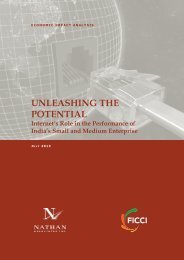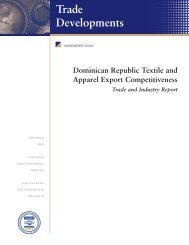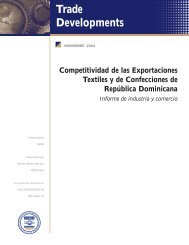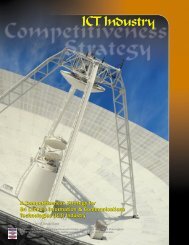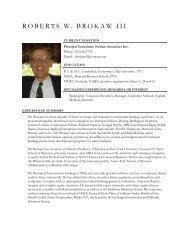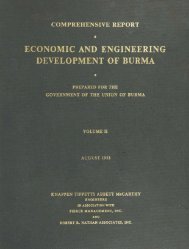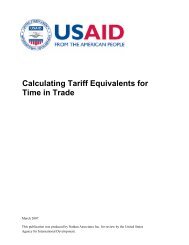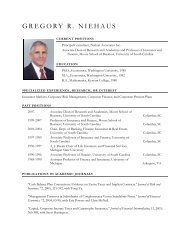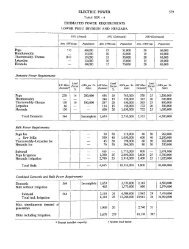Putting it to Work in Developing Countries - Nathan Associates
Putting it to Work in Developing Countries - Nathan Associates
Putting it to Work in Developing Countries - Nathan Associates
You also want an ePaper? Increase the reach of your titles
YUMPU automatically turns print PDFs into web optimized ePapers that Google loves.
eported <strong>to</strong> be a source of FDI throughout the<br />
former Soviet Union, particularly <strong>in</strong> natural<br />
resources. 25<br />
FUTURE BENEFITS<br />
If economic cond<strong>it</strong>ions rema<strong>in</strong> stable and liberalization<br />
of trade and <strong>in</strong>vestment advances, flows<br />
of South–South FDI will likely expand significantly<br />
over the next decade. Compet<strong>it</strong>ion and<br />
ris<strong>in</strong>g costs <strong>in</strong> the South’s larger home<br />
economies, new regional and global opportun<strong>it</strong>ies,<br />
and the need for oil and other resources will<br />
drive these flows. South–South FDI can have a<br />
strategic role <strong>in</strong> the develop<strong>in</strong>g world for several<br />
reasons. First, South–South flows may have a<br />
better effect on production capac<strong>it</strong>y and<br />
employment generation than other FDI: South<br />
mult<strong>in</strong>ationals tend <strong>to</strong> adopt a greenfield<br />
approach <strong>to</strong> FDI more often than developed<br />
country counterparts, and are more oriented <strong>to</strong><br />
labor-<strong>in</strong>tensive <strong>in</strong>dustries. 26<br />
Second, foreign <strong>in</strong>ves<strong>to</strong>rs based <strong>in</strong> develop<strong>in</strong>g<br />
countries may be better equipped <strong>to</strong> operate <strong>in</strong><br />
and bear the risk of other emerg<strong>in</strong>g country<br />
markets, thus multiply<strong>in</strong>g the potential sources<br />
of FDI for the develop<strong>in</strong>g world. Analysis suggests<br />
that the South’s mult<strong>in</strong>ationals are more<br />
will<strong>in</strong>g <strong>to</strong> focus on smaller or poorer markets<br />
than mult<strong>in</strong>ationals from the North (e.g., Ch<strong>in</strong>a<br />
and Russia <strong>in</strong> Mongolia, or India and Turkey <strong>in</strong><br />
Bangladesh).<br />
F<strong>in</strong>ally, develop<strong>in</strong>g country mult<strong>in</strong>ationals often<br />
have an advantage <strong>in</strong> develop<strong>in</strong>g economies,<br />
s<strong>in</strong>ce their products and processes are often better<br />
adapted <strong>to</strong> local economic and technological<br />
cond<strong>it</strong>ions. And spillovers are more likely, s<strong>in</strong>ce<br />
the technological gap between these mult<strong>in</strong>ationals<br />
and host economies is narrower than that<br />
between developed country mult<strong>in</strong>ationals and<br />
these host economies. All of these fac<strong>to</strong>rs should<br />
encourage and <strong>in</strong>tensify South–South FDI<br />
flows. 27<br />
54



